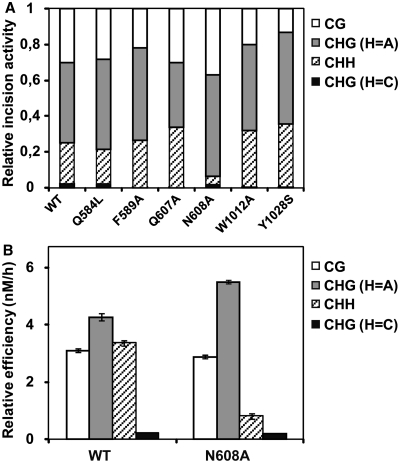Figure 6.
N608 contributes to sequence-context specificity. (A) Purified WT ROS1 or mutant variants (20 nM) were incubated at 30°C for 4 h with 51-mer double-stranded oligonucleotide substrates (20 nM) containing at position 29 of the labeled upper-strand a 5-meC residue in different sequence contexts. Products were separated in a 12% denaturing polyacrylamide gel and the amount of incised oligonucleotide was quantified by fluorescent scanning. For ease of comparison, the incision values for each substrate are normalized to the total incision detected in all four substrates for each individual enzyme. (B) Substrate processing ability of type ROS1 and the mutant variant N608 in different sequence contexts. Relative processing efficiencies were determined in kinetic assays as described in ‘Materials and Methods’ section. Purified proteins (20 nM), were incubated at 30°C with 51-mer double-stranded oligonucleotide substrates (20 nM) containing at position 29 of the labeled upper-strand a 5-meC residue in different sequence contexts. Reaction products were separated in a 12% denaturing polyacrylamide gel and quantified by fluorescence scanning. Values are means ± SE (error bars) from two independent experiments.

